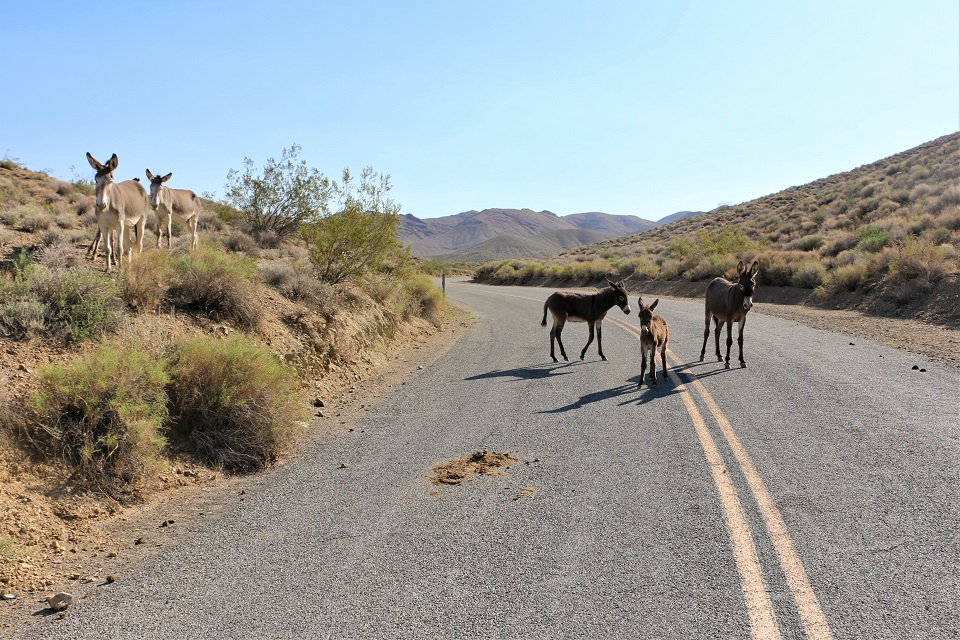News Release
You are viewing ARCHIVED content published online before January 20, 2025.
Please note that this content is NOT UPDATED, and links may not work. For current information,
visit https://www.nps.gov/aboutus/news/index.htm.

NPS photo by Mitch Gage
|
Subscribe
|
Contact: Jennette Jurado (NPS), 760-786-2389
Contact: Kate Miyamoto (BLM), 720-786-6729
DEATH VALLEY, Calif. – The National Park Service will be working with the Bureau of Land Management (BLM) to gather non-native burros from remote areas of Death Valley National Park from April 25 through mid-May 2022. Visitors to Death Valley National Park may experience traffic delays of up to 4 hours on a limited number of remote, unpaved roads during helicopter operations. Travel on the park’s paved roads will not be affected.Burro gathers within portions of the park are planned for the Panamint Mountains and near Darwin Falls. Unpaved roads within Butte Valley and Goler Wash are likely to have traffic delays up to 4 hours while burros are moving along roads, from April 25-27. These delays are for visitor and burro safety. Other areas of the park are not anticipated to need travel restrictions.
The burro gather is being done to protect native wildlife and ecosystems and to improve the condition of park wilderness. Burros are not native to the California desert, and feral burros found in the park are descendants of domestic donkeys abandoned by miners more than 100 years ago. NPS officials estimate there are now over 4,000 burros in the park.
Burros damage sensitive desert springs through trampling, overgrazing of vegetation, and fouling of the water. Burros compete with bighorn sheep and other native wildlife for scare desert resources such as food and water. Burros also damage important cultural sites, including historic cabins and archaeological sites. Park visitors have reported aggressive burros, and burros on roads are a driving hazard.
The BLM will conduct gather operations using the drive trap method, an effective and humane method moving the burros at a slow pace to capture sites. Gather operations will be conducted with care and compassion for the animals’ well-being and adhere to humane handling standards as outlined in the BLM’s Comprehensive Animal Welfare Program. The burros will then be transported to the BLM’s adoption facility in Ridgecrest, CA.
For information on how to adopt or purchase a wild horse or burro from the Ridgecrest Wild Horse and Burro Corrals call 760-384-5765 or visit www.blm.gov/whb. For information on projects and burro adoption from Peaceful Valley Donkey Rescue, visit donkeyrescue.org.
-www.nps.gov/deva-
Death Valley National Park is the homeland of the Timbisha Shoshone and preserves natural resources, cultural resources, exceptional wilderness, scenery, and learning experiences within the nation’s largest conserved desert landscape and some of the most extreme climate and topographic conditions on the planet. Learn more at www.nps.gov/deva.
Frequently asked questions
Q. How did the burros get here?
A. Burros are not native to the California desert. They were used as pack animals by miners settling the west more than 100 years ago. As miners’ claims dried up and they left the area, they turned their burros loose to fend for themselves.
Q. Why is the park removing the non-native burros?
A. We are removing the non-native burros for three reasons: 1) to protect food and water sources for native species such as desert bighorn sheep2) to protect cultural resources2) to protect visitorsBurros compete directly with native species like bighorn sheep for water and forage. Additionally, burros will browse on all vegetation in and around springs; often completely removing the vegetation. Burros can trample archeological sites and damage historic features such as cabins. As burro herds increase, many of the animals leave remote valleys looking for new territories to occupy; these roaming burros are finding their way to major roads and visitors have reported several collisions and near misses with burros. Burros are wild, powerful and unpredictable animals. Visitor interactions with these animals may result in injuries to visitors, burros, or both.
Q. How many burros are in the park?
A. We estimate 4,000 burros in Death Valley National Park. We continue to work with neighboring landowners to understand how many animals exist on the landscape.
Q. Why isn’t the park using fertility control?
A. Burros populations can increase nearly 20% annually. Fertility control methods for burros require administering contraceptive drugs to each animal every couple of years, which is logistically and financially challenging. The BLM uses contraceptive in some burro and wild horse herds to slow population growth. It is not an effective tool to get to zero population, which is the NPS management goal.
Q. What about the Wild Horse and Burro Act?
A. The Wild Horse and Burro Act only addresses animals on BLM and U.S. Forest Service lands, and does not include animals on National Park Service Lands. The NPS continues to work with the BLM to coordinate the management of burros in the adjacent herd management areas (HMAs) and minimize future migration of burros into NPS boundaries.
Q. How will burros be removed?
A. BLM contractors will use helicopters to herd burros out of the park and into pens set up on BLM land. Burros will then be moved to facilities in Ridgecrest, CA where they will receive care and be evaluated for adoption.
Q: Why use helicopters to gather the burros?
A: BLM gathers have proven to be more humane, effective, and efficient than other types of gather methods when large numbers of animals need to be removed over wide areas or rugged terrain, and they lead to lower rates of injury and mortality than comparable capture operations for native big game species. The BLM's helicopter-assisted gathers are conducted humanely, as most recently affirmed by a peer-reviewed scientific review of BLM gathers, as reported in The Horse: Your Guide to Equine Health Care.
Q: Is Peaceful Valley Donkey Rescue still removing burros from the park?
A: Yes!
Q. How can I adopt a burro?
A. Visit https://www.blm.gov/adoptahorse/howtoadopt.php
Last updated: April 22, 2022
